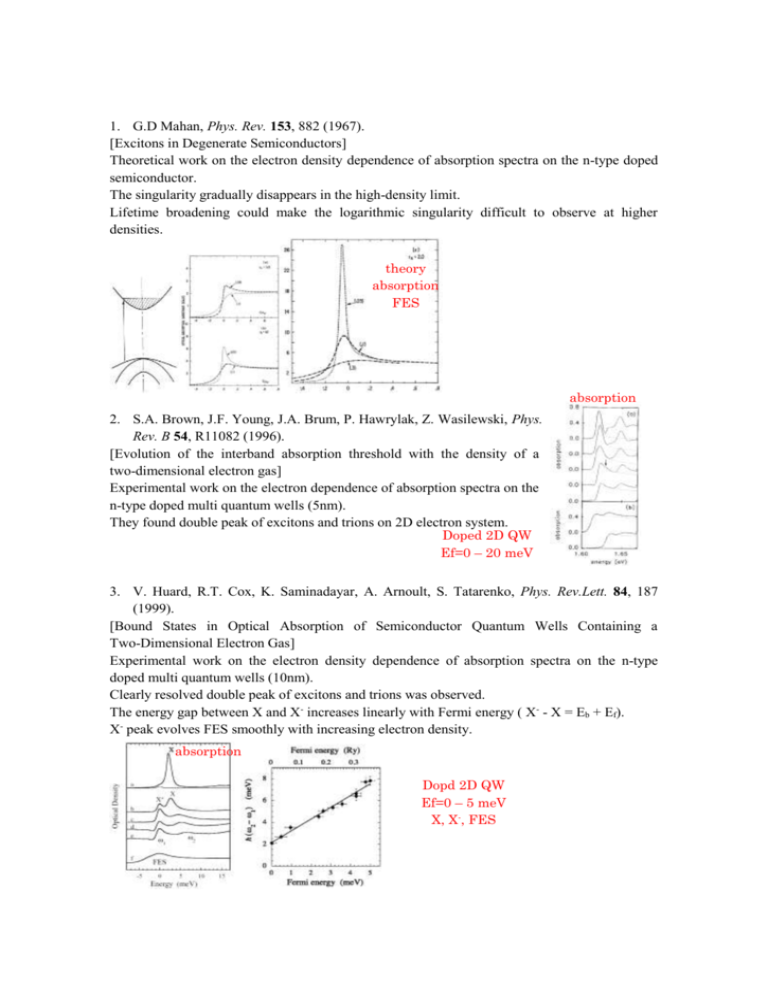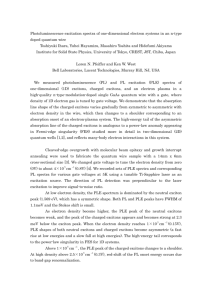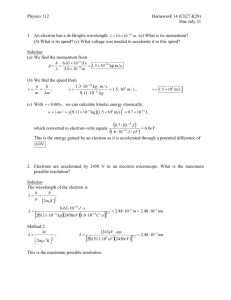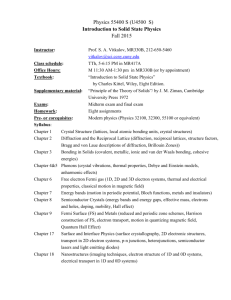phys dependence
advertisement

1. G.D Mahan, Phys. Rev. 153, 882 (1967). [Excitons in Degenerate Semiconductors] Theoretical work on the electron density dependence of absorption spectra on the n-type doped semiconductor. The singularity gradually disappears in the high-density limit. Lifetime broadening could make the logarithmic singularity difficult to observe at higher densities. theory absorption FES absorption 2. S.A. Brown, J.F. Young, J.A. Brum, P. Hawrylak, Z. Wasilewski, Phys. Rev. B 54, R11082 (1996). [Evolution of the interband absorption threshold with the density of a two-dimensional electron gas] Experimental work on the electron dependence of absorption spectra on the n-type doped multi quantum wells (5nm). They found double peak of excitons and trions on 2D electron system. Doped 2D QW Ef=0 – 20 meV 3. V. Huard, R.T. Cox, K. Saminadayar, A. Arnoult, S. Tatarenko, Phys. Rev.Lett. 84, 187 (1999). [Bound States in Optical Absorption of Semiconductor Quantum Wells Containing a Two-Dimensional Electron Gas] Experimental work on the electron density dependence of absorption spectra on the n-type doped multi quantum wells (10nm). Clearly resolved double peak of excitons and trions was observed. The energy gap between X and X- increases linearly with Fermi energy ( X- - X = Eb + Ef). X- peak evolves FES smoothly with increasing electron density. absorption Dopd 2D QW Ef=0 – 5 meV X, X-, FES 4. G. Yusa, H. Shtrikman, and I. Bar-Joseph, Phys. Rev. B 62, 15390 (2000). [Onset of exciton absorption in modulation-doped GaAs quantum wells] Experimental work on the electron density dependence of photo-current spectra on the n-type doped multi quantum wells (20nm) where the electron density is tuned by applying gate voltage. The energy gap between X and X- increases nonlinearly with Fermi Energy. PL Photo current Doped 2D QW Ef=0 – 1 meV X, X- 5. R.Kaur, A.J.Shields, J.L.Osborne, M.Y.Simmons, D.A.Ritchie, M.Pepper, Phys. stat. Sol. (a) 178, 465 (2000). [Electron Density Dependence of the Excitonic Absorption Thresholds of GaAs Quantum Wells] Experimental work on the electron density dependence of PLE spectra on the n-type doped multi quantum wells (10nm) where the electron density is tuned by applying gate voltage. The energy gap between X and X- increases linearly with Fermi Energy. Doped 2D QW X- peak evolves FES smoothly with increasing electron density. Ef=0 – 3 meV X, X-, FES PLE PL 6. J.M. Calleja, A.R. Goni, B.S.Dennis, J.S.Weiner, A.Pinczuk, S.Schmitt-Rink, L.N.Pfeiffer, K.West, J.F.Muller, A.E.Ruckenstein, Solid State Commun. 79, 911 (1991). [Large optical singularities of the one-dimensional electron gas in semiconductor quantum wires] Experimental work on the temperature dependence of PL and PLE spectra on the n-type doped multi quantum wires (25x100nm). Strongly enhanced FES was observed at high electron density. PL PLE Doped 1D QWR : Ef=3 - 4 meV 7. M.Fritze, A.V.Nurmikko, P.Hawrylak, Phys. Rev. B 48, 4960 (1993). [Many-electron excitons and Fermi-edge singularities in wide, parabolic (Al,Ga)As quantum wells] Experimental work on the temperature dependence of PL spectra on the n-type doped multi quantum wires (15x100nm). Strongly enhanced FES was observed at high electron density. PL Doped 1D QWR : Ef=20 meV 8. D.Y.Oberli, A.Rudra, E.Kapon, Physica E 11, 224 (2001). [Optical studies of modulation-doped V-groove quantum wires: Fermi-edge singularity] Experimental work on the temperature dependence of PL and PLE spectra on the n-type doped multi v-groove quantum wires (3x?nm). Weak FES was observed on both PL and PLE spectra at high electron density. Higher subbands affect the oscillator strength near the Fermi edge. PL PLE Doped 1D QWR Ef=20 meV 9. T.Melin, F.Laruelle, Phys. Rev. B 65, 195303 (2002). [Optical properties of remotely doped AlAs/GaAs coupled quantum wire arrays. II. Fermi-edge singularities] Experimental work on the electron density dependence of PL and PLE spectra on the n-type doped multi literal super lattice (LSLs) quantum wires (?x?nm). Strongly enhanced peak was observed on PL spectra at high electron density, which is due to the correlation effect with higher subbands. PL Doped 1D LSLs : Ef=??? meV 10. Hawrylak, Phys. Rev. B 44, 3821 (1991). [Optical properties of a two-dimensional electron gas: Evolution of spectra from excitons to Fermi-edge singularities] Theoretical work on the electron density, finite hole mass dependence of absorption spectra on the n-type doped semiconductor quantum well (2D electron system). By considering of electron spin, he predicted there are two thresholds of excitons and trions. The singularity gradually disappears with small hole mass. absorption 11. M.Takagiwa, T.Ogawa, J. Phys. Chem. Solids 63, 1587 (2002). [Crossover of optical spectra from an excitonic feature to the Fermi-edge singularity] Theoretical work on the electron density dependence of absorption spectra on the n-type doped semiconductor quantum well (2D electron system). They pointed out there are three thresholds for excitons, trions and non-interacting electron-hole pair. absorption 12. Ogawa, Phys. Rev. Letters 68, 3638 (1992). [Fermi-edge singularity in one-dimensional systems] Theoretical work on the electron-electron interaction and electron-hole interaction dependence of critical exponent of Fermi edge singularity with finite hole mass on the 1D electron system. He predicted the critical exponent is independent of hole mass. The singularity becomes weak with increasing electron density due to increasing electron-electron correlation. 13. Ogawa, Physica B 249, 185 (1992). [Optical detection of critical exponents in the Tomonaga–Luttinger liquid] Theoretical work on the critical exponent of Fermi edge singularity of 1D Tomonaga-Luttinger liquid. He predicted the critical exponent is affected by Tomonaga-Luttinger feature. 14. Hawrylak, Solid State Commun. 81, 525 (1992). [Excitonic effects in optical spectra of a quasi-one-dimensional electron gas] Theoretical work on the finite hole mass dependence of absorption and emission spectra on the 1D electron system. FES appears weak when holes are localized on potential disorders. FES appears strong when holes are localized on acceptor impurity. emission emission 15. F.J.Rodriguez, C.Tejedor, Phys. Rev. B 47, 1506 (1993). [Optical singularities in doped quantum-well wires] Theoretical work on the electron density, temperature, finite hole mass dependence of emission and absorption spectra on the n-type doped semiconductor quantum wire (1D electron system). FES becomes weak with high temperature, small hole mass, increasing electron density. Emission at Fermi edge becomes enhanced if there is higher subband near the Fermi edge. absorption emission emission emission 16. A.E. Ruckenstein, S. Schmitt-Rink, Phys. Rev. B 35, 7551 (1987). Theoretical work on the many-body effect, finite hole mass dependence FES feature on the n-type doped semiconductor structure (low-dimensional electron system). FES becomes weak with small hole mass due to hole recoil. The low energy tail of FES corresponds to hole recoil energy. absorption 17. H. Akiyama, L. N. Pfeiffer, A. Pinzuk, K. W. West, and M. Yoshita, Solid State Commun. 122, 169 (2002). PL PL Doped 1D T-wire Ef=0 - 3 meV Ef=0 - 6 meV








